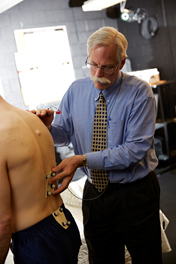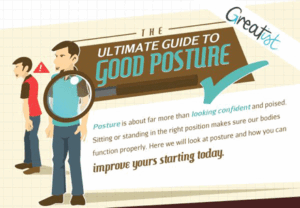Let’s Talk About Sex!
There are three areas of conversation that we are told too avoid at all cost while in the treatment room; sex, politics and religion. These subjects are clearly based upon ones personal opinions and beliefs and are rarely needed to provide sound clinical outcomes in massage therapy.
Today, I am making an exception. New research has been revealed that can help thousands of patients who routinely suffer from low back pain during sex. Over my 20 plus years in the industry, I have seen many patients who complain of pain during sex. Not wanting to abstain from what is commonly considered to be a pleasurable experience, I am often asked what the best position is for avoiding the occurrence of back pain during sex. Until now, my answer has been the same as the majority of health care professionals, “spooning”.
“If you survey the primary care physicians around the world, they will tell you that they are absolutely lost when a couple comes to them and says that ‘sex causes back pain and in fact we are now abstinent or celibate because we’re knackered for two month afterwards’,” says McGill.
But alas, thanks to the efforts of Dr. Stuart McGill, one of the foremost authorities in low back pain and PhD candidate, Natalie Sidorkewicz at Waterloo University, they have conclude that spooning may in fact be one of the worst positions to avoid back pain during sex.
“Before now, spooning was often recommended by physicians as the one position that fit all. But as we’ve discovered, that is not the case,” said Natalie Sidorkewicz, a PhD candidate at Waterloo and lead author on the paper. “Sex positions that are suitable for one type of back pain aren’t appropriate for another kind of pain.”
 McGill and Sidorkewicz set out to build an evidenced based practical ‘atlas’ matching sexual positions and styles with potential back pain triggers. Ten healthy couples were recruited and filmed using motion capture and infra-red technology while they had sex. The researchers were in a separate room where they could hear, but not see, the participants. Electrodes were used to record muscle activity in certain parts of the body to get an idea of force.
McGill and Sidorkewicz set out to build an evidenced based practical ‘atlas’ matching sexual positions and styles with potential back pain triggers. Ten healthy couples were recruited and filmed using motion capture and infra-red technology while they had sex. The researchers were in a separate room where they could hear, but not see, the participants. Electrodes were used to record muscle activity in certain parts of the body to get an idea of force.
In the end, the results of the study have provided health care professionals with a general ‘atlas’ of how to best limit the degree of back pain one may experience during sex by providing suggested positions based upon the specific movements that elicit back pain. The most significant of which was that more hinging that takes place at the hips and the less hinging of the spine, the better off their back is.
I encourage you to watch the video below to learn more about the results of the study. Regardless of whether or not you currently experience back pain during sex, this study will likely come in handy at some point in your present of future experiences considering that 85% of us will experience debilitating back pain at some point in our lives.
Until next month, Feel Better!
Link to full article:
https://uwaterloo.ca/news/news/back-pain-killing-your-sex-life-groundbreaking-study-reveals
Ready to #feelbetter?
You're just a click away from a wicked good massage!
-

60 Minute Massage Gift Card
$170.00 Add to cart -

90 Minute Massage Gift Card
$255.00 Add to cart -

Mini Aer Small Room Air Purifier
$149.00 Add to cart -
Sale!

Thera-Pearl Sports Pack/Hot Cold
Original price was: $14.99.$12.99Current price is: $12.99. Add to cart -

3 Somadome Sessions Gift Card
$135.00 Add to cart -

TheraBand CLX Connective Loop
$14.99 Select options -

6 Somadome Sessions Gift Card
$270.00 Add to cart -
Sale!

Biofreeze
Original price was: $14.99.$12.99Current price is: $12.99. Add to cart
Passion Mountain
I was at an event recently and was asked by somebody how I could STILL be so passionate for what I do. He said, “What I mean is that you talk about what you do with the passion of child flipping through a new pack of baseball cards. I wish I was that passionate about…
Read MoreFish You Should Scale Back On
New Englander’s love their seafood and we deepen our love affair every summer when our favorite crustaceans, ‘lobstah’ is a plentiful. But what is the best seafood for us and what are the ones that we should be staying away from regardless of how yummy they may be? Monterey Bay Aquarium has combined data from…
Read MoreSports are a Great Metaphor
It’s no secret that my life has always revolved around athletics. From my early days playing pop warner football, through my college years of lacrosse and on into the various community leagues since, being part of a team has always been where I feel most comfortable. What I enjoy most about being part of a…
Read MoreWhat is an Expert?
“An expert is someone widely recognized as a reliable source of technique or skill whose faculty for judging or deciding rightly, justly, or wisely is accorded authority and status by their peers or the public in a specific well-distinguished domain.” – Wikipedia This past month I flew to Atlanta to present a few classes in…
Read MoreThe Power of a Hug
Originally Posted 5/1/2014; following the 1 year anniversary of the Boston Marathon Bombings and our mission to rebound after these horrible attacks on our city. We helped orchestrate the ‘One Run for Boston’; a 3328.2 NON-STOP running relay from LA to Boston, raising over $500K for the victims and survivors of the events of 4/20/2013.…
Read MoreTips from the Table
Without fail, every marathon season, I am asked by my patients, what kind of advice I would offer up to them as they prepare to run the Boston marathon. I first admit that I have never (nor will ever) run a marathon, but given my unique insight of spending 1000’s of hours alone in a…
Read MoreShoulder Impingement
The glenohumeral joint is a highly complex articulation. It has the greatest range of motion of any joint in the body. However, its increased motion occurs at the expense of stability, requiring the soft tissues to play a more critical role in maintaining joint integrity. As a result of increased mechanical demands, numerous soft-tissue injuries…
Read MoreTrain, train, train. Train of fools.
In my seventeen years as a massage therapist, I am still amazed by some of the things I see in my office. Being situated 1/10th of a mile from the finish line of one of the most prestigious marathons in the world, the Boston Marathon, we see more than our fair share of runners coming…
Read MoreAchilles Tendon Disorder
Achilles Tendon Disorder Massage therapists see many clients with active lifestyles. Running, jumping, dancing, climbing, or any number of other activities can put serious stress on the Achilles tendon (AT). AT disorders also can contribute to biomechanical disorders in the foot and lower extremity. That is why it is important for the massage practitioner to…
Read More


